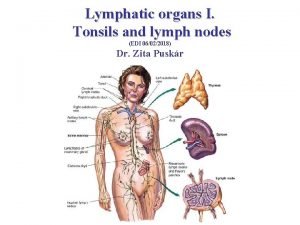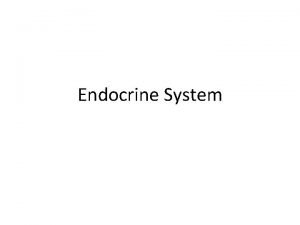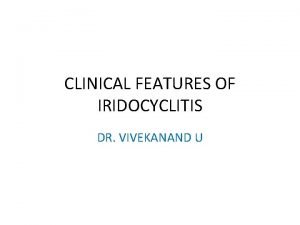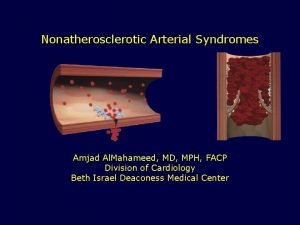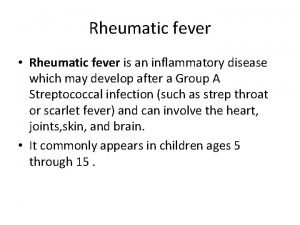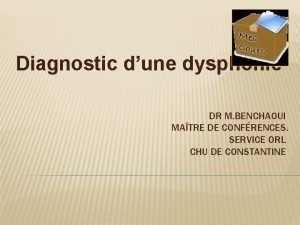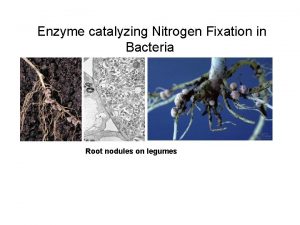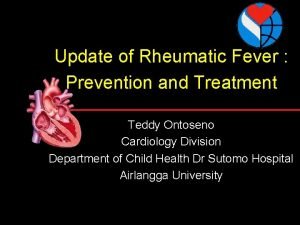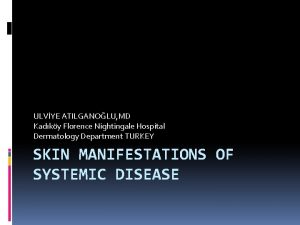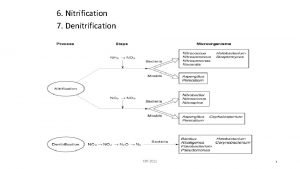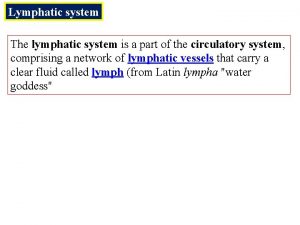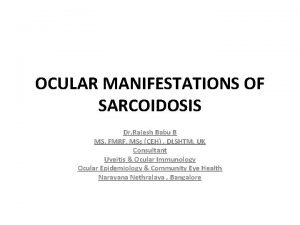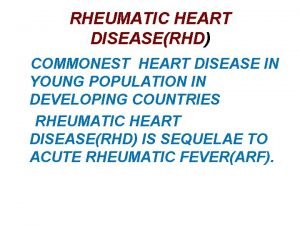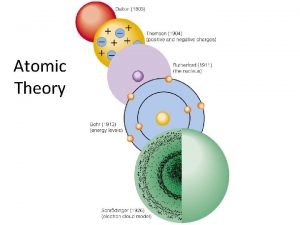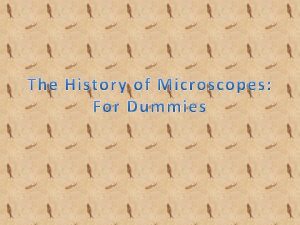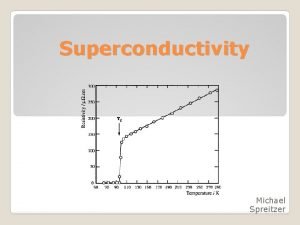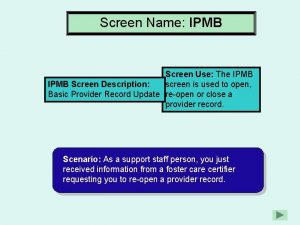Screen discovered nodules What next 18 th Annual




























- Slides: 28

Screen discovered nodules: What next? 18 th Annual Perspectives in Thoracic Oncology Anil Vachani, MD, MS Assistant Professor of Medicine Director, Lung Nodule Program University of Pennsylvania Medical Center

Disclosures • Research Funding – NIH, DOD – Integrated Diagnostics, Allegro Diagnostics, • Scientific Advisory Board – Allegro Diagnostics

Nodule, Biopsy and Benign Disease Rates Percent of patients in screened arm 5 4 3 2 1 0 RCT

Ost & Gould, AJRCCM 2011

Assessing the Probability of Cancer • Most Important Factors to consider: – Nodule size and characteristics – Smoking history – Age – Family history of lung cancer – Emphysema

http: //www. brocku. ca/lung-cancer-risk-calculator

http: //www. brocku. ca/lung-cancer-risk-calculator

Importance of Nodule Size Confirmed Lung Cancer Yes No PPV (%) 4 -7 mm 18 (7%) 3642 (53%) 0. 5 7 -10 mm 35 (13%) 2079 (30%) 1. 7 11 -20 mm 111 (41%) 821 (12%) 11. 9 21 -30 mm 58 (22%) 137 (2%) 29. 7 > 30 mm 45 (17%) 64 (1%) 41. 3 NLST Investigators. NEJM 2013

Guidelines

Fleischner Society Guidelines Nodule Size Low Risk High Risk ≤ 4 mm No follow-up needed 12 mo > 4 -6 mm 12 mo 6 -12 mo > 6 -8 mm 6 -12 mo 3 -6 mo > 8 mm 3 mo, PET, and/or biopsy Mc. Mahon, et al. Radiology 2005; 237: 395 -400


Recommendations for Subsolid Nodules Nodule Type Management Recommendation Solitary pure GGN ≤ 5 mm No CT follow-up required

Thick vs. Thin Sections for Small Nodules Naidich D P et al. Radiology 2013; 266: 304 -317

Recommendations for Subsolid Nodules Nodule Type Management Recommendation Solitary pure GGN ≤ 5 mm No CT follow-up required > 5 mm Initial CT at 3 months; annual surveillance CT for minimum 3 years

Pure GGN larger than 5 mm • Lesions are frequently due to preinvasive AAH or AIS • Up to 20% of persistent GGOs are benign • Growth of a GGO can suggest presence of an invasive adenocarcinoma

Serial Imaging to Assess Growth (1 mm cuts) Naidich D P et al. Radiology 2013; 266: 304 -317

Rapid Enlargement of a GGO Naidich D P et al. Radiology 2013; 266: 304 -317

Recommendations for Subsolid Nodules Nodule Type Management Recommendation Solitary pure GGN ≤ 5 mm No CT follow-up required > 5 mm Initial CT at 3 months; annual surveillance CT for minimum 3 yrs Solitary part-solid Initial CT at 3 months; if persistent and solid component < 5 mm, then yearly CT for min of 3 yrs. If persistent and solid component > 5 mm, then biopsy or surgery


Rationale • Part solid nodules have a high likelihood of malignancy • Development of a solid component within a pure GGO

Recommendations for Subsolid Nodules Nodule Type Management Recommendation Solitary pure GGN ≤ 5 mm No CT follow-up required > 5 mm Initial CT at 3 months; annual surveillance CT for minimum 3 yrs Solitary part-solid Initial CT at 3 months; if persistent and solid component < 5 mm, then yearly CT for min of 3 yrs. If persistent and solid component > 5 mm, then biopsy or surgery Multiple subsolid nodules Pure GGNs < 5 mm Obtain follow-up CT at 2 and 4 years Pure GGNs > 5 mm without a dominant lesion Initial CT at 3 months; then annual surveillance for a minimum of 3 yrs Dominant nodule with Initial CT at 3 months; If persistent, biopsy or part solid or solid component surgical resection, especially for lesions with > 5 mm solid component

Multiple subsolid lesions with single dominant focus. Naidich D P et al. Radiology 2013; 266: 304 -317

PET Scans Erasmus, et al. Clinics in Chest Medicine 2008

PET Scans • Sensitivity ~ 85% • Specificity ~ 80% • Less accurate for: – Smaller lesions – Subsolid nodlues

Establishing a Tissue Diagnosis • Bronchoscopy vs. CT guided TTNA Modality Sensitivity Traditional bronchoscopy (screen detected) 15% Navigational bronchoscopy 70% CT guided TTNA 90%

Establishing a Tissue Diagnosis • Bronchoscopy vs. CT guided TTNA Modality Sensitivity Traditional bronchoscopy (screen detected) 15% Navigational bronchoscopy 70% CT guided TTNA 90% • Data based on case series • Risks of CT guided TTNA – Pneumothorax 15 -27%

Conclusions • Lung nodules are increasingly common • Important to elicit patient preferences • Management should include – Estimation of cancer risk • Nodules ≤ 8 mm are infrequently malignant – CT scan surveillance is best option in most cases • If high likelihood of malignancy and low surgical risk, consider surgical evaluation • Emergence of peripheral blood biomarkers

THANK YOU
 X.next = x.next.next
X.next = x.next.next Screen small screen offscreen
Screen small screen offscreen Hemicapsule
Hemicapsule Thyroid symptoms
Thyroid symptoms Festooned pupil
Festooned pupil Subcutaneous nodules
Subcutaneous nodules Bread and butter pericarditis
Bread and butter pericarditis Microlaryngoscopie en suspension
Microlaryngoscopie en suspension Root nodules
Root nodules Subcutaneous nodules
Subcutaneous nodules Breakdown of nutrients
Breakdown of nutrients Mcb 101
Mcb 101 Regenerative nodules of liver
Regenerative nodules of liver Subcutaneous nodules
Subcutaneous nodules Stevens johnson syndrome
Stevens johnson syndrome Intermediate uveitis
Intermediate uveitis Root name
Root name Peyer's patches
Peyer's patches Globular maxillary cyst
Globular maxillary cyst Daisy destruction
Daisy destruction Bussaca nodules
Bussaca nodules Aschoff bodies diagram
Aschoff bodies diagram Rheumatoid arthritis in hands
Rheumatoid arthritis in hands Which scientist discovered neutron
Which scientist discovered neutron Who discovered electrivity
Who discovered electrivity Discovery of cell
Discovery of cell Who discovered
Who discovered Who discovered uranium
Who discovered uranium Who discovered
Who discovered


